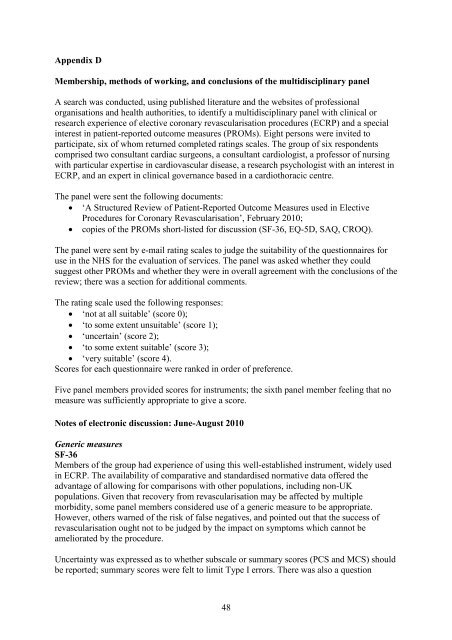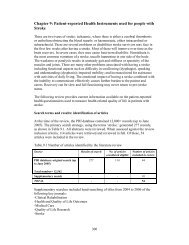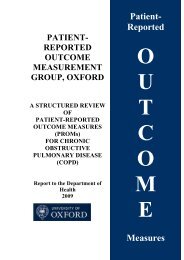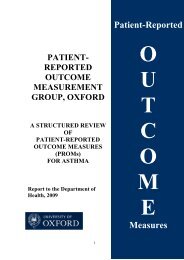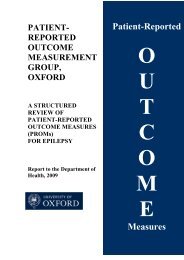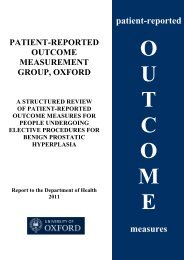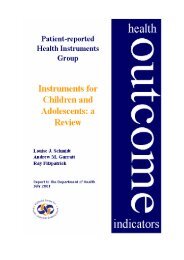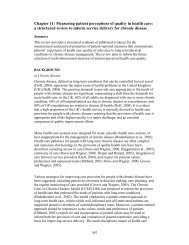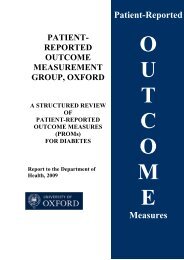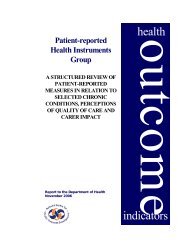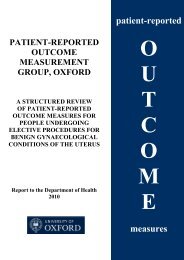2010 review - Patient-Reported Outcomes Measurement - University ...
2010 review - Patient-Reported Outcomes Measurement - University ...
2010 review - Patient-Reported Outcomes Measurement - University ...
Create successful ePaper yourself
Turn your PDF publications into a flip-book with our unique Google optimized e-Paper software.
Appendix D<br />
Membership, methods of working, and conclusions of the multidisciplinary panel<br />
A search was conducted, using published literature and the websites of professional<br />
organisations and health authorities, to identify a multidisciplinary panel with clinical or<br />
research experience of elective coronary revascularisation procedures (ECRP) and a special<br />
interest in patient-reported outcome measures (PROMs). Eight persons were invited to<br />
participate, six of whom returned completed ratings scales. The group of six respondents<br />
comprised two consultant cardiac surgeons, a consultant cardiologist, a professor of nursing<br />
with particular expertise in cardiovascular disease, a research psychologist with an interest in<br />
ECRP, and an expert in clinical governance based in a cardiothoracic centre.<br />
The panel were sent the following documents:<br />
‘A Structured Review of <strong>Patient</strong>-<strong>Reported</strong> Outcome Measures used in Elective<br />
Procedures for Coronary Revascularisation’, February <strong>2010</strong>;<br />
copies of the PROMs short-listed for discussion (SF-36, EQ-5D, SAQ, CROQ).<br />
The panel were sent by e-mail rating scales to judge the suitability of the questionnaires for<br />
use in the NHS for the evaluation of services. The panel was asked whether they could<br />
suggest other PROMs and whether they were in overall agreement with the conclusions of the<br />
<strong>review</strong>; there was a section for additional comments.<br />
The rating scale used the following responses:<br />
‘not at all suitable’ (score 0);<br />
‘to some extent unsuitable’ (score 1);<br />
‘uncertain’ (score 2);<br />
‘to some extent suitable’ (score 3);<br />
‘very suitable’ (score 4).<br />
Scores for each questionnaire were ranked in order of preference.<br />
Five panel members provided scores for instruments; the sixth panel member feeling that no<br />
measure was sufficiently appropriate to give a score.<br />
Notes of electronic discussion: June-August <strong>2010</strong><br />
Generic measures<br />
SF-36<br />
Members of the group had experience of using this well-established instrument, widely used<br />
in ECRP. The availability of comparative and standardised normative data offered the<br />
advantage of allowing for comparisons with other populations, including non-UK<br />
populations. Given that recovery from revascularisation may be affected by multiple<br />
morbidity, some panel members considered use of a generic measure to be appropriate.<br />
However, others warned of the risk of false negatives, and pointed out that the success of<br />
revascularisation ought not to be judged by the impact on symptoms which cannot be<br />
ameliorated by the procedure.<br />
Uncertainty was expressed as to whether subscale or summary scores (PCS and MCS) should<br />
be reported; summary scores were felt to limit Type I errors. There was also a question<br />
48


